The AMD A8-7670K APU Review: Aiming for Rocket League
by Ian Cutress on November 18, 2015 8:00 AM ESTGaming Benchmarks: Low End
To satisfy our curiosity regarding low-power gaming, as well as dual graphics arrangements, we ran our regular suite through each processor. On this page are our integrated graphics results, along with a cheaper graphics solution in the R7 240 DDR3 and, in the case of AMD, both of these together in dual graphics mode.
Alien: Isolation
If first-person survival mixed with horror is your sort of thing, then Alien: Isolation, based off of the Alien franchise, should be an interesting title. Developed by Creative Assembly and released in October 2014, Alien: Isolation has won numerous awards, ranging from Game Of The Year to several top 10s/25s and Best Horror titles, ratcheting up over a million sales by February 2015. Alien: Isolation uses a custom-built engine that includes dynamic sound effects and should be fully multicore enabled.
For low-end graphics, we test at 720p with Ultra settings, whereas for mid- and high-range graphics, we bump this up to 1080p, taking the average frame rate as our marker with a scripted version of the built-in benchmark.

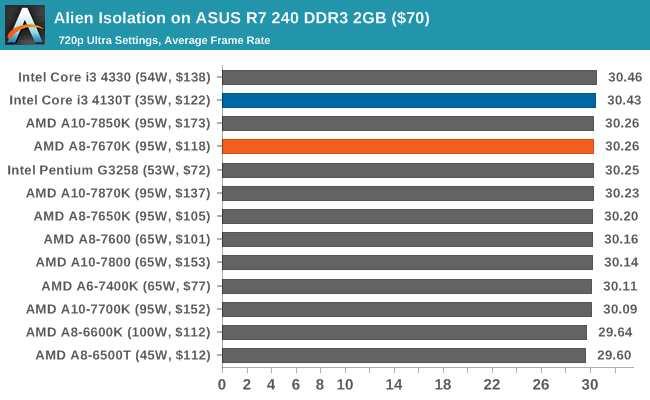
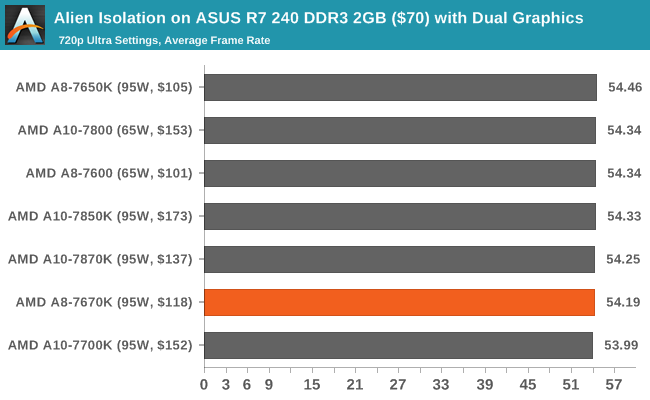
Total War: Attila
The Total War franchise moves on to Attila, another Creative Assembly development, and is a stand-alone strategy title set in 395AD where the main story line lets the gamer take control of the leader of the Huns in order to conquer parts of the world. Graphically, the game can render hundreds/thousands of units on-screen at once, all with their individual actions, and can put some of the big cards to task.
For low-end graphics, we test at 720p with performance settings, recording the average frame rate. With mid- and high-range graphics, we test at 1080p with the quality setting. In both circumstances, unlimited video memory is enabled, and the in-game scripted benchmark is used.
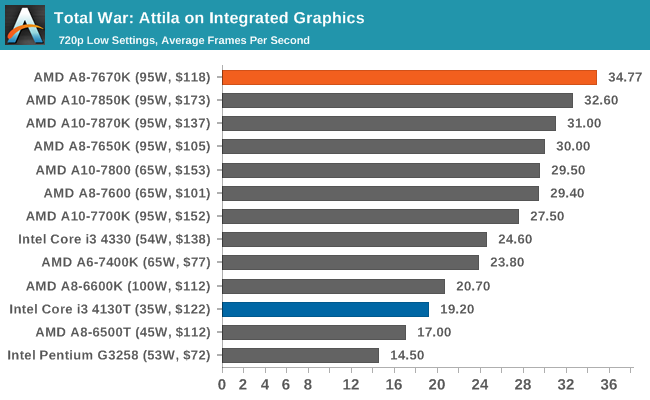

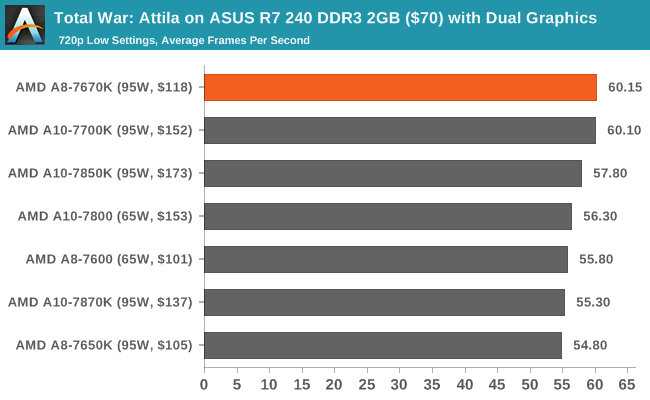
Grand Theft Auto V
The highly anticipated iteration of the Grand Theft Auto franchise finally hit the shelves on April 14, 2015, with both AMD and NVIDIA in tow to help optimize the title. GTA doesn’t provide graphical presets, but it opens up the options to users and extends the boundaries by pushing even the hardest systems to the limit using Rockstar’s Advanced Game Engine. Whether the user is flying high in the mountains with long draw distances or dealing with assorted trash in the city, when cranked up to maximum, it creates stunning visuals but hard work for both the CPU and the GPU.
For our test, we have scripted a version of the in-game benchmark, relying only on the final part, which combines a flight scene with an in-city drive-by, followed by a tanker explosion. For low-end systems, we test at 720p on the lowest settings, whereas mid- and high-end graphics play at 1080p with very high settings across the board. We record both the average frame rate and the percentage of frames under 60 fps (16.6 ms).

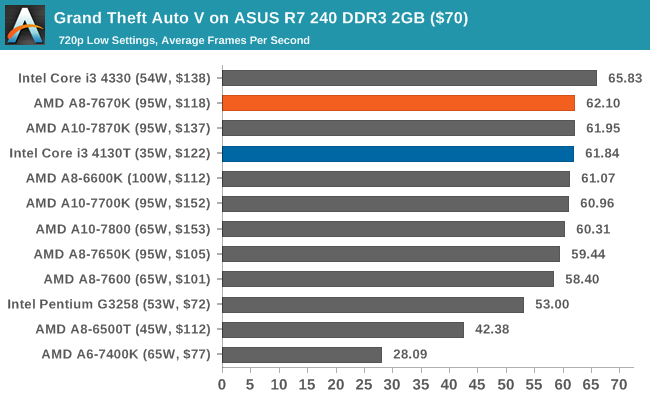
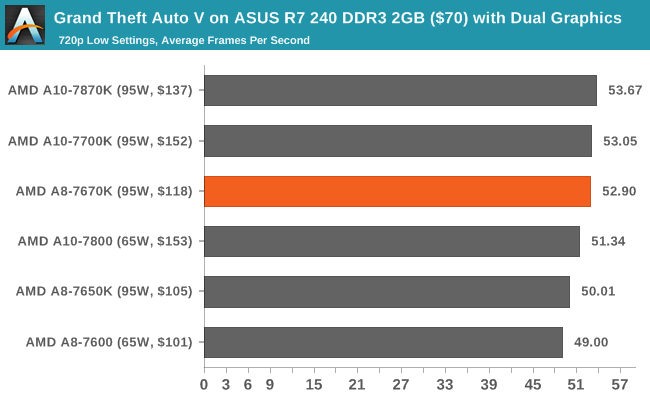
GRID: Autosport
No graphics test is complete without some input from Codemasters and the Ego engine, which means for this round of testing, we point toward GRID: Autosport, the next iteration in the GRID and racing genre. As with our previous racing testing, each update to the engine aims to add in effects, reflections, detail and realism, with Codemasters making "authenticity" a main focal point for this version.
GRID’s benchmark mode is very flexible, and as a result, we created a test race using a shortened version of the Red Bull Ring with 12 cars doing two laps. The player car is in focus throughout this benchmark and starts last, but usually finishes second or third. For low-end graphics, we test at 1080p and medium settings, whereas mid- and high-end graphics get the full 1080p maximum. Both the average and the minimum frame rates are recorded.
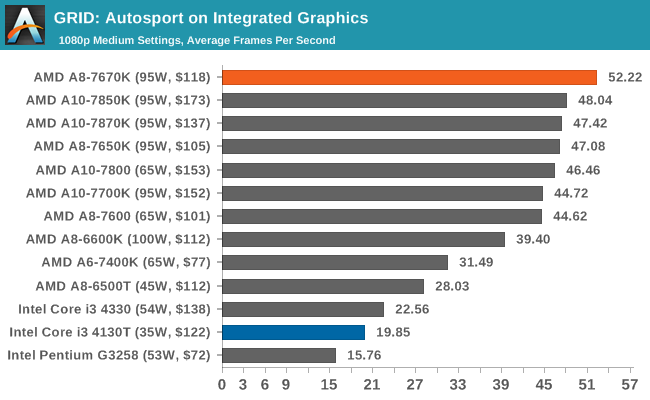
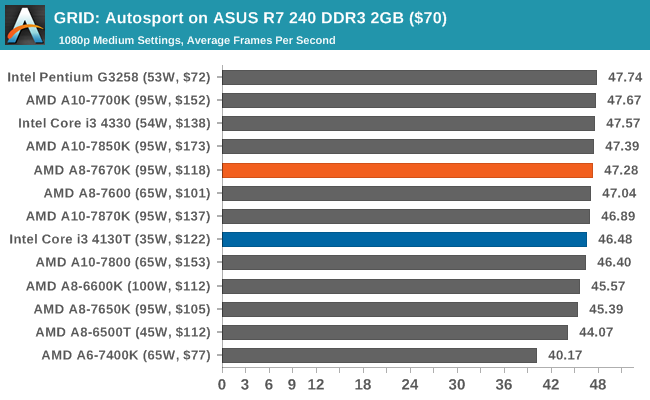
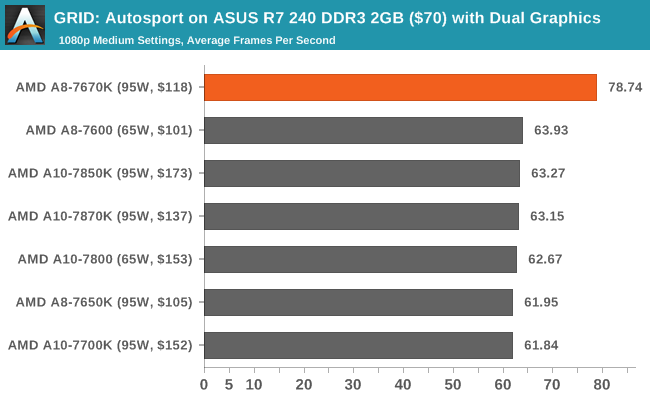
For whatever reason, the A8-7670K gets a good showing in the integrated tests, especially in dual graphics mode, with an abnormally high score. Some other issue might be at play here and warrants further testing.
Middle-Earth: Shadows of Mordor
The final title in our testing is another battle of system performance with the open-world action-adventure title Shadow of Mordor. Produced by Monolith using the LithTech Jupiter EX engine and numerous detail add-ons, SoM goes for detail and complexity to a large extent, despite having to be cut down from the original plans. The main story was written by the same writer as Red Dead Redemption, and it received Zero Punctuation’s Game of The Year in 2014.
For testing purposes, SoM gives a dynamic screen resolution setting, allowing us to render at high resolutions that are then scaled down to the monitor. As a result, we get several tests using the in-game benchmark. For low-end graphics, we examine at 720p with low settings, whereas mid- and high-end graphics get 1080p Ultra. The top graphics test is also redone at 3840x2160, also with Ultra settings, and we also test two cards at 4K where possible.
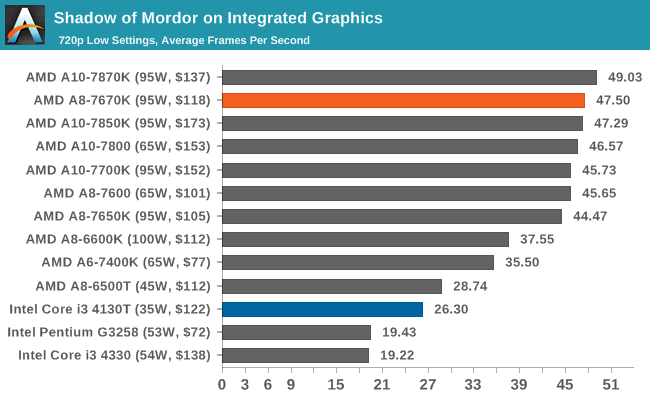
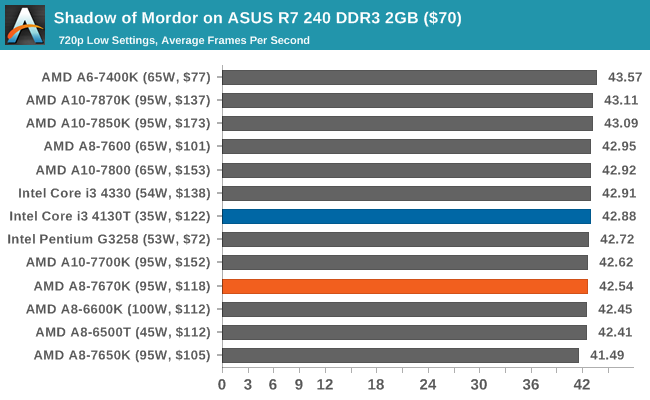
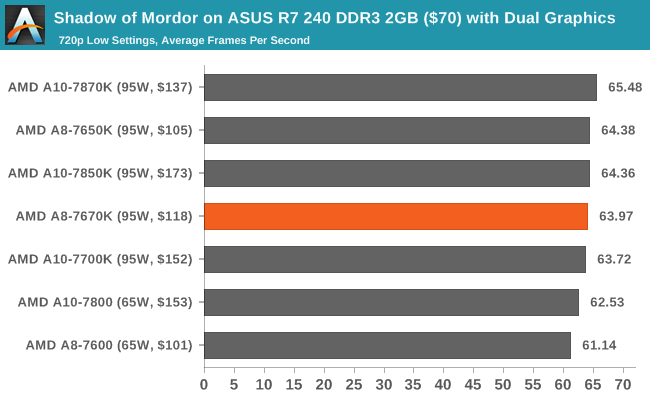















154 Comments
View All Comments
BurntMyBacon - Thursday, November 19, 2015 - link
@medi03: "I would point you to the fact that Netburst outsold superior Athlon 64s 4 to 1."True, a superior architecture doesn't guarantee better sales, even at better prices. However, Dribble didn't accuse this solution of being inferior for the market it is targeting. He stated:
@Dribble: "No one is buying, ..." and "... the market isn't there."
I don't entirely agree, though (by CPU sales) the market doesn't seem to be very large and is clearly low margin. These are not the processors that will save AMD's business. Zen will likely be the most important CPU architecture in the company's history (whether the design is good/bad/novel/obvious).
medi03 - Thursday, November 19, 2015 - link
I would point you to the fact that Netburst outsold superior Athlon 64s 4 to 1.JoeMonco - Thursday, November 19, 2015 - link
But your silly *facts* don't matter. [Year+1] with the release AMD [Microarchitecture+1] is gonna finally beat Intel! And I know this because my irrational brand loyalty says so!!barleyguy - Thursday, November 19, 2015 - link
You mocking irrational brand loyalty is irony at its finest. ;-)JoeMonco - Thursday, November 19, 2015 - link
I don't see what the irony is supposed. Criticizing AMD doesn't mean I like Intel. ARM is the only real competition that Intel faces.hojnikb - Thursday, November 19, 2015 - link
How much did you spend on that ram ?I bet you could get pentium+4g of ram and a nice 250X (or even 260x on sale) for around the same money.
Thats the problem with apus. They need fast ram in dual channel to be taken advantage of.
yannigr2 - Thursday, November 19, 2015 - link
An A8 7600 costs only $20-$30 more than a Pentium? 8GBs of 1866-2000MHz costs only $10-$20 more than 8GB 1333Mhz? And the card you get in the APU is a little faster than an R7 240 as the review shows.So, in the end you save $30-$40 for the same if not a tiny better gaming experience. This is HUGE if you don't have the money, or if you are a retail shop that tries to create an ultra cheap system that you can market it as gaming and also have one less part in there that makes the assembly easier and also lowers the possibility of an RMA because of the extra part(the discrete card).
AMD can't sell much, because Intel controls the market, people who don't know about hardware buy the Intel brand and individuals who are asked to help others to build such low cost machines, usually exclude AMD from the beginning without even considering it as an option, or even try as hard as they can to make other avoid AMD's solutions. That's even when AMD's solutions are the perfect solutions for specific cases, and those are the same people who constantly cry about competition. My example in my previous post proves that and it was an example based on a last week's case.
silverblue - Thursday, November 19, 2015 - link
Fast RAM which isn't exactly at a premium anymore... at least, right now. I just took a quick glance at HyperX Savage prices on Amazon and a 16GB (2x8) kit was £64 to £65 for 1600 and 1866MHz, and £68 for 2400MHz, with 2133MHz being a little more still. I know, it's a small sample for a single product range, and a lot of these look to have had massive reductions recently, but right now it's not really an expense going with faster RAM.If you play games that benefit from Hybrid Crossfire, it's an option, certainly more than it used to be, however it's still not at the level that I would consider to be worthwhile outside of that particular scenario, and scaling is still minimal even when it does work (in general).
I would like to know what AMD's current CPU market share is. People are forever saying that nobody is buying AMD, however based on popularity on www.dabs.com it appears that the 860K is the top CPU, with the 8320E in second place. The i3-6100 is in third place.
JoeMonco - Thursday, November 19, 2015 - link
25fps? Is that supposed to be impressive?yannigr2 - Thursday, November 19, 2015 - link
You are wrong. I guess two years ago you would have been absolutely sure that this generation consoles wouldn't sell because the hardware wasn't strong enough to run latest AAA titles at the highest possible settings.